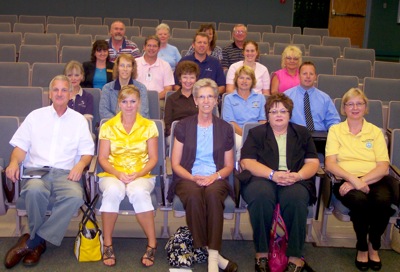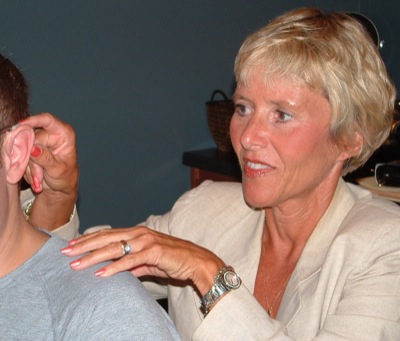Wednesday, September 8th, 2010
If tests succeed, state will treat lake
By Nancy Allen

Photo by Mark Pummell/The Daily Standard
Sites around Grand Lake where projects are underway or planned to help resolve water quality issues. At a public meeting Tuesday night state officials revealed the locations for six alum test sites. The original plan called for two larger locations, but six smaller demonstrations were settled upon.
GRAND LAKE - If pilot tests using aluminum sulfate (alum) and silica work to curb Grand Lake's toxic blue-green algae, the state will find the money to treat the entire lake, a state official said Tuesday.
More than 300 people attended a public meeting at the Celina fieldhouse to learn about the tests.
The test using silica (sand) as a food source for good diatom algae to eat and out-compete the lake's dominant harmful blue-green algae began last week near the Celina Rotary Lighthouse.
The alum test will start Sept. 20 at six sites totaling 53 acres at the west beach, Harmon's Landing channel, the county 4-H camp, West Bank boat ramp and two channels at Otterbein Retirement Community. Alum should make the phosphorus bind together and drop to the lake's bottom, taking away the blue-green algae's food source.
"We will leave no stone unturned," Ohio EPA Director Chris Korleski told the crowd. "If experts come back and tell us this is going to make things better, we'll find the money, but we're going to need your help."
Korleski said he is contacting the U.S. EPA and the USDA's Natural Resources Conservation Service for potential funding sources.
The silica test is being paid for with $25,000 from the Ohio Department of Agriculture and the alum test with a $250,000 Ohio EPA grant. Whole lake treatment using alum could cost up to $10 million. The state has no estimate on the cost for a total lake treatment using silica.
Crowd members wrote their questions on cards that were submitted to the panel, read aloud and then answered.
Some questions posed include:
Why not open the West Bank spillway tubes in the fall to flush out algae-laden water?
Sean Logan, director of the Ohio Department of Natural Resources: It's not a viable solution to curb algae. Core sediment samples taken in the middle of the lake from west to east show most of the phosphorous is on the lake's east side due to prevailing winds. So opening the west spillway would not have much affect on getting old water out and new in. Also, the new water contains phosphorous.
Why not do sizable dredging instead of using alum or silica?
Logan: Whole lake dredging remains unfeasible due to huge costs and the lack of land for the dredged material. The state's plan does include site specific dredging at creeks flowing into the lake that will give the "biggest bang for our buck." The state would consider a request by a private entity that wants to harvest the dredge material. So far, the state has not received any requests. The state does have a permit request from the city of Celina for dredging that is still being processed.
Creating islands in the lake with dredge material is possible, but the perimeter of that would need to be constructed so the phosphorous-laden sediment does not escape into the lake.
It seems farmers are blamed for the lake's condition. Is this true and what is being done to educate them?
Logan: It's not about blame, it's about data. The way to gain the most improvement is to help the agriculture community reduce phosphorous runoff. (Farmland accounts for about 85 percent of the acres in the watershed.) Additional funds and staff have come to the watershed to help farmers implement conservation practices.
Would a sales tax in Mercer and Auglaize counties be applicable to generate funds for dredging, rip rapping, etc.?
Logan: That is a question for local officials.
Have there been any confirmed cases of human illness caused by the lake's toxic algae?
Alvin Jackson, director of the Ohio Department of Health: No. A total of 21 cases associated with Grand Lake have been reported. Of those, six are probable, five remain under investigation and 10 were deemed not to be cases.
Will adding silica and alum to the lake make it more shallow?
Korleski, Ohio EPA: No. The amount of silica used will be at micro-levels, and the alum should actually cause the phosphorous in the existing sediment to compress and take up less space on the lake bottom.
Has alum been used successfully before?
Korleski: Yes, in hundreds of lakes and water bodies around the world, but never in one the size of Grand Lake.
Who will decide which treatment to use for the entire lake if both tests are successful?
Korleski: State agencies based on consultation with local agencies and scientists. The state will first need to see results before determining whether to use one or both treatments on the lake.
Can we tap into natural springs under the lake (to get more fresh water in the lake)?
Harry Gibbons of Tetra Tech, the consulting firm the state hired to conduct the alum test: This is not a good idea because this could cause a draining affect. Natural springs, if they exist, also may contain phosphorous.
What are the side effects to humans and animals from alum?
Gibbons: There are none. A person would be exposed to more aluminum by drinking tea than by spending time in the lake after it's dosed. Longer studies show that using alum improve fish populations over time because habitat was improved.
Persons whose questions were not read due to meeting time constraints will be able to see the written answers by viewing them on the Ohio EPA's Web site (
www.epa.ohio.gov) in the next few weeks. They also may call Ohio EPA Public Involvement Coordinator Darla Peelle at 614-644-2160 or e-mail her at darla.peelle@epa.state.oh.us.
Also speaking and answering questions were Mike Eckhardt from ODA; Tom Knapke of the Grand Lake Restoration Commission; Russ Gibson, Ohio EPA environmental manager; and Ross Youngs of Algaeventure Systems, Marysville, the company leading the silica test.
"We'll be back, we're not going away," Korleski said in closing. "We're going to keep working on this and we'll be back to keep you posted on the results of the studies."

Photo by Mark Pummell/The Daily Standard
Harry Gibbons of Tetra Tech, the consulting firm hired by the state to oversee a pilot test to treat Grand Lake with alum, answers a question Tuesday night at the Celina fieldhouse. More than 300 people attended.





